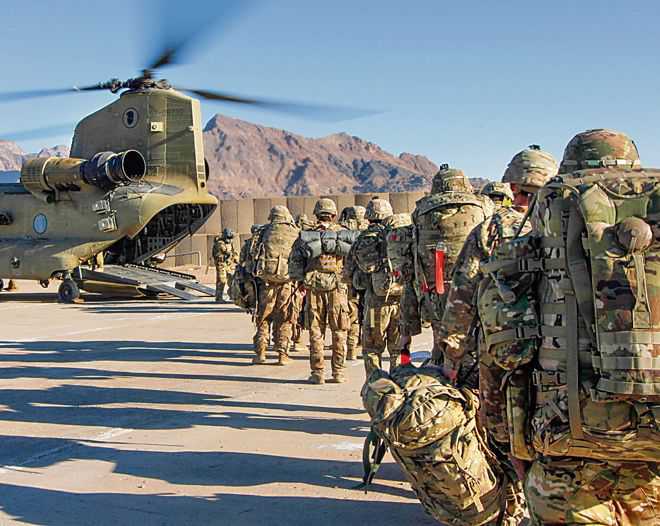
G Parthasarathy
Former diplomat
It now is evident that President Trump is determined to sign a virtual surrender document with the Taliban. This would permit him to ensure that there is no US combat military presence in Afghanistan when America goes for presidential elections, scheduled for November 3, 2020. Trump’s electoral support, drawn predominantly from a White Caucasian base, would like all their ‘boys’ back home to celebrate Christmas next year.
Figures show that US casualties from 2003 to 2018 were 2,372 killed and 20,320 wounded while an estimated 1.10 lakh Afghan soldiers and civilians paid with their lives. Is this example of the US entering conflicts and leaving the conflict zone without a decisive outcome something new? The Vietnam Conflict ended with an ignominious US withdrawal from South Vietnam. The then US ambassador, Graham Martin, was evacuated by helicopter from Saigon after North Vietnamese forces entered the South Vietnamese capital. An estimated 1.8 million Vietnamese were dead. US casualties were 31,952 killed and 2 lakh wounded.
Vietnam was united under Communist Party rule, which continues. But Vietnam did not become, as the US feared, a Communist Party ruled, Soviet/Chinese satellite. Vietnam has a close strategic relationship with the US today, aimed at containing Chinese expansionism in the South China Sea. This, after the Vietnamese gave the Chinese a bloody nose in 1979, when Deng Xiaoping promised to teach Vietnam a ‘lesson’ and invaded Vietnam.
One looks back at the Iraq conflict with similar sentiments. President Saddam Hussein was backed by the US during the Iran-Iraq war. The US, thereafter, forced Iraq to withdraw after it invaded Kuwait in the first Gulf War in 1990-1991. While the Iraqis reportedly lost about 1 lakh soldiers, US casualties were 383 killed. The Second Gulf War in 2003, based on false US allegations that Saddam was producing nuclear weapons, resulted in around 1.1 lakh Iraqi deaths. While Saddam, a Sunni, was anti-Iranian, the present Shia-dominated Iraq government avoids involvement in Arab-Iranian sectarian rivalries. US participation in conflicts has seldom produced the desired results.
Much has been written about Trump’s assertion during Imran Khan’s visit that Modi asked him to mediate on Kashmir. The Washington Post revealed last month that Trump had made 10,796 misleading statements since he assumed office in 2017! New Delhi has, therefore, been restrained in responding to his falsehoods, recognising that Trump has similarly offended countries like Canada and Mexico and European allies like France, Germany and Japan. He has no respect for international treaties like FTA, WTO guidelines, climate change and international agreement on Iran’s nuclear programme. The only ‘leader’ that Trump appears to admire is North Korea’s Kim Jong-un, who is not exactly a champion of democratic values!
It is too early to conclude how realistic Trump’s belief is that he can persuade Imran Khan, and more importantly, General Bajwa to facilitate a smooth withdrawal of US forces. Trump has bent backwards to please the Taliban and snub the elected government of President Ashraf Ghani, with presidential elections in Afghanistan scheduled for September this year. The Afghan army is, meanwhile, suffering huge casualties. Pakistan has moved deftly to persuade China, Russia, Turkey, Iran and Qatar to follow the US example of placing the Taliban and the Ghani government on the same pedestal. But Ghani has little prospect now of seriously influencing US policies.
The Taliban should not be regarded as omnipotent. It is an exclusively Pashtun organisation. Pashtuns constitute about 40% of Afghanistan’s population. The Taliban is tenacious, but survives with Pakistan’s patronage. Moreover, large sections of Pakistani Pashtuns, especially in the tribal areas bordering Afghanistan, are affiliated to groups like Tehrik-e-Taliban and Pashtun Tahafuz Movement, comprising Pashtuns with nationalistic inclinations, with scant regard for the Durand Line. These Pashtuns, on both sides of the disputed Line, will not take kindly to coercive Pakistani military actions against their brethren. With the exit of US troops, many Afghan Pashtuns are not likely to be responsive to Pakistan army’s demands to end their backing of Pakistani Pashtun brethren living across the disputed border.
Over the past two decades, India has won substantial goodwill across the ethnic divide in Afghanistan by adopting a non-interfering approach to developments within Afghanistan. The Taliban has never had a comfortable relationship with minority communities like Tajiks, Uzbeks, Turkmen and Shia Hazaras. Pashtun leaders like former President Hamid Karzai and Tajik leaders like Governor of Balkh province Atta Mohammad Noor and former Afghan intelligence chief Amrollah Saleh, regard India as a trusted friend. India’s economic and educational assistance to Afghanistan has won widespread regard. It would, however, also be prudent to keep channels of communication with the Taliban open.
Much is now dependent on how Trump plays out his withdrawal schedule. There are pressures from the State Department and the military to avoid a precipitous withdrawal and retain a residual presence. If Trump decides to fully pull out before the elections, the Americans could well be forced to leave Afghanistan ignominiously. If they phase out withdrawal and give time to the Afghan National Army and ethnic militias to be armed and trained, they would have created a credible force to face the Taliban. Finally, if southern Afghanistan is destabilised, Pakistan’s own stability will face challenges.
